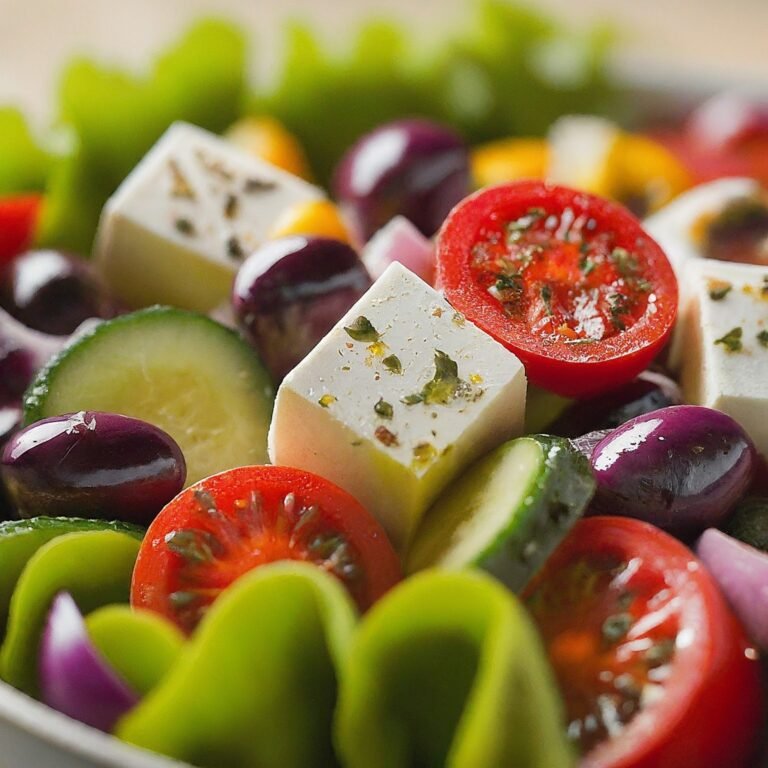Hey there, food lovers! Are you ready to transport your taste buds to the sunny shores of Greece? Well, buckle up because we’re about to dive into the world of Greek salads. This isn’t just any Greek salad recipe – it’s the ultimate guide to creating a mouthwatering, authentic Greek salad that’ll have you saying “Opa!” with every bite. So, let’s get chopping and discover the secrets to making the perfect Greek salad!
Why Greek Salad?
Before we jump into the nitty-gritty, let’s talk about why Greek salad is such a fantastic dish:
- Nutrient-packed: Loaded with fresh veggies, it’s a nutritional powerhouse.
- Versatile: Great as a side dish or a light main course.
- Quick and easy: No cooking required – just chop and toss!
- Refreshing: Perfect for hot summer days or as a light, crisp addition to any meal.
The Essential Ingredients
Let’s break down the star players in a traditional Greek salad:
- Tomatoes: Ripe, juicy, and preferably heirloom for the best flavor.
- Cucumbers: English or Persian cucumbers work great.
- Red onion: Adds a nice bite and beautiful color.
- Green bell pepper: For a crisp, fresh crunch.
- Kalamata olives: These bring a rich, salty flavor.
- Feta cheese: Creamy, tangy, and oh-so-Greek!
- Extra virgin olive oil: The backbone of the dressing.
- Red wine vinegar: For a zingy kick.
- Dried oregano: The quintessential Greek herb.
Now, let’s get into the details of how to make this salad shine!
Choosing the Best Ingredients
The secret to an amazing Greek salad lies in the quality of your ingredients. Here’s what to look for:
- Tomatoes: Go for ripe, in-season tomatoes. Heirloom varieties offer great flavor and color.
- Cucumbers: English or Persian cucumbers are less watery and have fewer seeds.
- Feta cheese: Opt for Greek feta made from sheep’s milk for the most authentic taste.
- Olive oil: Always use extra virgin olive oil for the best flavor.
For more tips on selecting the best produce, check out this guide from the USDA:
The Perfect Greek Salad Recipe
Now, let’s get to the good stuff – the recipe!
Ingredients (serves 4-6):
- 4 large ripe tomatoes, cut into chunks
- 1 large English cucumber, cut into half-moons
- 1 green bell pepper, chopped
- 1/2 red onion, thinly sliced
- 1 cup Kalamata olives, pitted
- 200g Greek feta cheese, cubed
- 2 tablespoons extra virgin olive oil
- 1 tablespoon red wine vinegar
- 1 teaspoon dried oregano
- Salt and freshly ground black pepper to taste
Instructions:
- In a large bowl, combine the chopped tomatoes, cucumber, bell pepper, and red onion.
- Add the Kalamata olives and gently toss to combine.
- In a small bowl, whisk together the olive oil, red wine vinegar, dried oregano, salt, and pepper.
- Pour the dressing over the vegetables and toss gently to coat.
- Add the cubed feta cheese on top.
- Sprinkle with a little extra oregano and serve immediately.
Pro tip: For the best flavor, let the salad sit for about 15 minutes before serving to allow the flavors to meld.
Customizing Your Greek Salad
While the traditional recipe is fantastic, don’t be afraid to mix it up! Here are some delicious variations:
- Add some grilled chicken or shrimp for a protein boost.
- Toss in some chickpeas for extra fiber and protein.
- Try adding some fresh herbs like mint or dill for an aromatic twist.
- Include some crushed rusks or pita chips for a crunchy element.
The Health Benefits of Greek Salad
Greek salad isn’t just delicious – it’s also incredibly good for you! Here’s why:
- Low in calories, high in nutrients: Perfect for those watching their weight.
- Rich in antioxidants: Tomatoes are packed with lycopene, a powerful antioxidant.
- Heart-healthy: The olive oil and olives provide healthy fats that are great for your heart.
- Hydrating: With water-rich vegetables, it helps keep you hydrated.
For more information on the Mediterranean diet’s health benefits, check out this article from the Mayo Clinic.
Pairing Suggestions
Greek salad is versatile enough to pair with a variety of dishes. Here are some ideas:
- Serve alongside grilled fish or chicken for a complete meal.
- Pair with a crisp white wine like Assyrtiko for a true Greek experience.
- Serve with warm pita bread for a light lunch.
Storing Your Greek Salad
If you have leftovers (though that’s rare with this delicious salad!), here’s how to store them:
- Keep the dressing separate if you’re not serving immediately.
- Store in an airtight container in the refrigerator for up to 2 days.
- Add fresh herbs or an extra splash of dressing before serving leftovers to refresh the flavors.
Common Questions About Greek Salad
- Can I make Greek salad ahead of time? Yes, but keep the dressing separate and add it just before serving to prevent the vegetables from getting soggy.
- Is Greek salad really Greek? Absolutely! Known as “horiatiki” in Greece, this salad is a staple of Greek cuisine.
- Can I use a different cheese if I don’t have feta? While feta is traditional, you could use other brined cheeses like halloumi in a pinch.
- How can I make this salad vegan? Simply omit the feta cheese or use a vegan feta alternative.
Conclusion
There you have it – the ultimate guide to creating a perfect Greek salad. With its fresh ingredients, simple preparation, and incredible flavor, this salad is sure to become a staple in your recipe repertoire. Whether you’re serving it as a side dish at a barbecue, enjoying it as a light lunch, or using it to transport yourself to the Greek isles without leaving your kitchen, this Greek salad is a true Mediterranean delight. So grab your chopping board, and let’s get Greek!





















